You can now transform your smartwatch into a personal health assistant by simply asking “What’s my heart rate?” and receiving instant spoken responses. Modern wearables use AI algorithms to analyze your voice patterns, detecting early illness signs before symptoms appear while monitoring essential signs with clinical precision. These devices sync seamlessly with healthcare systems, provide emergency alerts, and offer hands-free access to personalized health insights that’ll revolutionize how you manage your wellness.
The Evolution From Fitness Tracking to Medical-Grade Health Monitoring
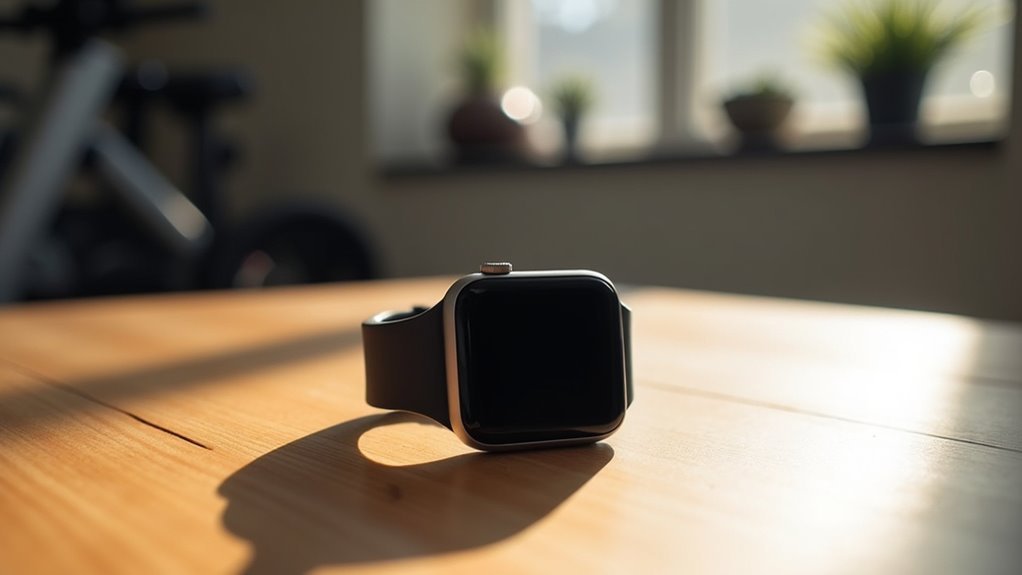
While early wearables like eyeglasses and abacus rings served basic functional purposes centuries ago, today’s health monitoring devices have transformed into sophisticated medical instruments that track your essential signs with clinical precision.
You’ve witnessed this evolution accelerate dramatically since the 2010s when Fitbit introduced mass-market fitness tracking. What started as simple step counters has evolved into devices that monitor heart rhythm irregularities, oxygen saturation, and glucose levels.
Modern wearables now incorporate AI algorithms that predict health risks and provide personalized insights beyond basic activity tracking. The market projections indicate this technology sector is expected to reach $419 billion by 2028, reflecting the massive adoption and innovation in health-focused wearable devices.
You’re no longer limited to counting calories burned—today’s medical-grade devices offer continuous monitoring of chronic conditions, earning regulatory approvals that distinguish them from traditional fitness trackers through clinical validation.
Voice-Activated Health Commands Revolutionizing Wearable Interaction
You can now ask your smartwatch “What’s my heart rate?” or “How did I sleep last night?” and get instant spoken responses without touching the screen.
Your wearable device responds to natural conversation, letting you access blood oxygen levels, stress metrics, and step counts while your hands stay free for other tasks.
When your health data hits concerning thresholds, voice alerts immediately notify you with spoken warnings about irregular heart rhythms or elevated stress levels. This continuous monitoring capability enables early disease detection through real-time health tracking throughout your day.
Natural Language Health Queries
As wearable technology evolves beyond simple step counting, voice-activated health queries are transforming how you interact with your devices and understand your body’s signals.
You can now ask natural language questions like “Why didn’t I sleep well last night?” or “What’s causing my irregular heart rate?” and receive AI-generated insights that connect your physiological data with contextual factors.
This conversational approach eliminates barriers between you and your health data. Instead of scrolling through confusing charts, you’ll get personalized explanations that help you understand complex trends and correlations.
NLP technology decodes your verbal inputs into actionable health commands, making wearables more intuitive and responsive. Advanced models can integrate multimodal encoding to interpret both your spoken queries and raw sensor data simultaneously for more accurate health insights. You’re no longer just monitoring—you’re actively engaging with thorough health intelligence through simple voice interactions.
Hands-Free Metric Access
Because your hands are often occupied during workouts, daily activities, or emergencies, voice-activated health commands have become the next frontier in wearable technology interaction.
You can now access your heart rate, oxygen levels, and step count without touching your device. This hands-free approach revolutionizes how you monitor your health, especially during physical activities where traditional touch interfaces become impractical.
Voice-activated wearables use advanced speech recognition to interpret your commands accurately, providing real-time health data instantly. Healthcare professionals are already utilizing similar voice-activated technology in clinical settings to streamline communication and reduce workflow interruptions.
You’ll find this technology particularly valuable during emergencies when quick access to health metrics or calling for help could be life-saving.
- Access heart rate and oxygen levels through simple voice commands
- Receive medication reminders and appointment alerts hands-free
- Call for emergency help using voice activation during falls or health crises
- Monitor stress and fatigue levels by analyzing your voice patterns
- Get real-time health tips and guidance without device interaction
Real-Time Voice Alerts
While traditional wearables require you to glance at screens or tap interfaces for health updates, real-time voice alerts transform your device into an intelligent health companion that speaks directly to you. Your wearable instantly notifies you when significant conditions emerge, reducing response time during health emergencies. You’ll receive timely medication reminders and status updates that help manage chronic conditions like diabetes and heart disease.
Voice-activated devices capture real-time health data through bidirectional microphones, enabling immediate feedback on your essential signs. When your device detects irregularities, it adjusts alert frequency and urgency based on your current activity and biometric analysis.
This hands-free interaction proves especially valuable if you have mobility or vision impairments, ensuring you never miss critical health information. The integration of AI enhances real-time gesture recognition and context-aware interactions, optimizing both user experience and power consumption in these advanced wearable systems.
Real-Time Vital Sign Monitoring Through Voice-Enabled Smartwatches
When you raise your wrist and speak to your smartwatch, you’re accessing a revolution in personalized healthcare that transforms how essential signs are monitored and managed. Your voice commands instantly retrieve real-time updates on heart rate, blood oxygen levels, and respiratory patterns without touching a single button.
The device’s optical sensors and bio-impedance technology work continuously, while voice AI provides medication reminders and personalized health guidance tailored to your current status.
This hands-free approach eliminates barriers for users with mobility or vision impairments, making health management truly accessible. Your speech patterns themselves become diagnostic tools, as AI algorithms analyze vocal biomarkers to detect subtle health changes that traditional sensors might miss. Advanced optical coupling minimizes interference from ambient light, ensuring accurate readings even in varying environmental conditions.
- Voice commands deliver instant access to heart rate, blood oxygen, and respiratory data
- Speech recognition reduces barriers for users with mobility or vision impairments
- AI analyzes vocal patterns to detect neurological and respiratory health changes
- Hands-free medication reminders adapt dynamically to your current health status
- Continuous sensor integration provides seamless monitoring without manual input
AI-Powered Predictive Health Analytics on Your Wrist
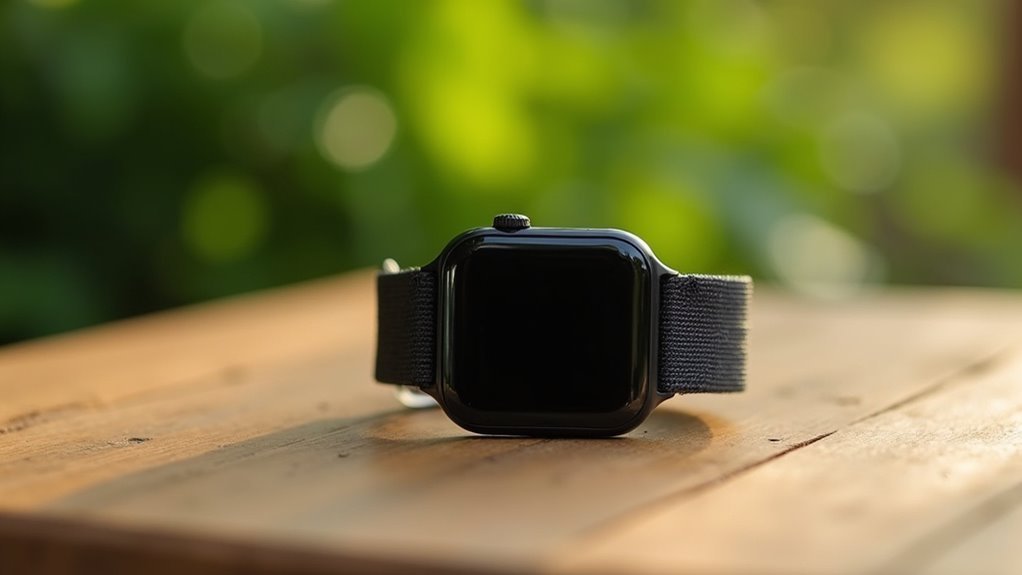
Your smartwatch doesn’t just track your current health—it predicts your future wellness with unprecedented accuracy. AI algorithms continuously analyze your voice patterns, heart rate variability, and blood oxygen levels to identify potential health issues before they become severe. This predictive approach transforms your wrist into a powerful early warning system.
| Predictive Capability | Health Benefit |
|---|---|
| Chronic Disease Detection | Identifies diabetes and hypertension early |
| Risk Pattern Analysis | Prevents severe health complications |
| Personalized Interventions | Creates tailored treatment recommendations |
| Long-Term Outcome Assessment | Guides healthcare decisions and planning |
You’ll receive timely alerts when anomalies appear, enabling proactive interventions that could save your life. These data-driven insights help healthcare providers develop personalized treatment plans while reducing costly hospital visits through continuous remote monitoring. Advanced wearables now integrate augmented reality capabilities to enhance real-time health visualization and improve telemedicine experiences.
Seamless Integration With Healthcare Systems and Electronic Health Records
Your voice metrics don’t exist in isolation—they’re designed to sync directly with your healthcare provider’s electronic health record system in real-time.
You’ll access a unified platform where your vocal biomarkers combine with data from other wearables and medical devices, creating a thorough health picture. Machine learning algorithms help filter and prioritize the most clinically relevant voice patterns from the continuous data stream.
This interoperable network guarantees your voice-derived health insights flow seamlessly between different healthcare systems, so every provider you visit has immediate access to your complete health story.
Real-Time EHR Synchronization
As healthcare systems become increasingly interconnected, real-time EHR synchronization transforms how patient data flows between providers, enabling instant access to essential information across multiple platforms.
You’ll experience streamlined workflows where your crucial signs, medication changes, and lab results update instantly across all connected systems. Event-driven architectures push updates without delay, guaranteeing your healthcare team makes informed decisions during critical moments.
Modern synchronization platforms eliminate duplicate data entry while maintaining secure connections between dozens of healthcare systems. You benefit from faster care coordination as providers access your complete medical history in seconds rather than hours. This end-to-end synchronization capability ensures that patient information flows seamlessly between all connected healthcare platforms without manual intervention.
- Instant crucial sign monitoring – Your wearable data syncs immediately with clinical systems
- Automated medication tracking – Real-time updates prevent dangerous drug interactions
- Seamless appointment coordination – Scheduling syncs across all provider platforms instantly
- Enhanced clinical decision-making – Providers access complete patient data without delays
- Regulatory compliance automation – Accurate timestamps guarantee legal documentation standards
Unified Care Platform Access
While healthcare providers once struggled with fragmented systems and isolated data repositories, unified care platforms now eliminate these barriers by creating seamless bridges between disparate healthcare technologies.
You’ll benefit from centralized patient data that integrates with EHRs and clinical systems, giving authorized providers real-time access across specialties. This eliminates information silos and incomplete records that previously hindered your care.
Your healthcare team can now collaborate seamlessly through multidisciplinary communication tools, sharing care plans and resource needs instantly.
You’ll experience enhanced coordination for complex cases involving both medical and social health factors. The platform maintains HIPAA compliance while enabling secure messaging, file sharing, and teleconsultations.
You can access your integrated records through multiple channels, increasing engagement while providing your providers with thorough, personalized care plans based on your complete health history. These cloud-based platforms reduce hardware expenses by eliminating the need for costly on-premises infrastructure.
Interoperable Data Sharing Networks
Nearly 90% of hospitals have adopted certified EHR technology, creating unprecedented opportunities for seamless data exchange that directly impacts your healthcare experience.
Your health data now flows across interconnected networks that break down traditional silos between healthcare providers. When you visit different specialists or switch hospitals, your complete medical history travels with you through sophisticated exchange networks.
These systems integrate summary care records directly into EHRs, ensuring your providers see your full health picture instantly. The transformation means faster diagnoses, reduced duplicate tests, and more coordinated care across your entire healthcare team. Despite digital advances, mail or fax remains the most common method for sending and receiving care records between healthcare facilities.
- Multi-network participation: 39% of hospitals connect through multiple national networks simultaneously
- Four-domain functionality: 70% of hospitals can send, receive, find, and integrate your patient data
- Bulk data capabilities: 74% support analytics for population health management
- Cross-network simplification: TEFCA initiatives reduce complexity between different systems
- Point-of-care access: Electronic information availability dramatically improved for all hospital sizes
Emergency Response and Fall Detection via Voice-Activated Alerts
When emergencies strike and you’ve fallen, every second counts in getting help—which is why voice-activated alert systems represent a crucial advancement in fall detection technology.
These systems integrate seamlessly with smartwatches, allowing you to initiate emergency calls instantly through simple voice commands. You’ll find voice activation particularly valuable when manual dexterity becomes compromised during emergencies.
Current fall detection devices aren’t perfectly accurate, with studies showing significant false alarm rates—one reported 83 false alarms out of 84 incidents.
However, voice-activated systems enhance your emergency response capabilities by providing immediate access to help. The technology proves especially beneficial for seniors, offering an intuitive way to request assistance.
With AI and machine learning improvements, these voice-integrated systems continue evolving to provide more reliable, accessible emergency response solutions. Monthly costs for medical alert systems typically range from $20 to $34, making these life-saving technologies accessible to most households.
Personalized Health Insights Through Natural Language Processing
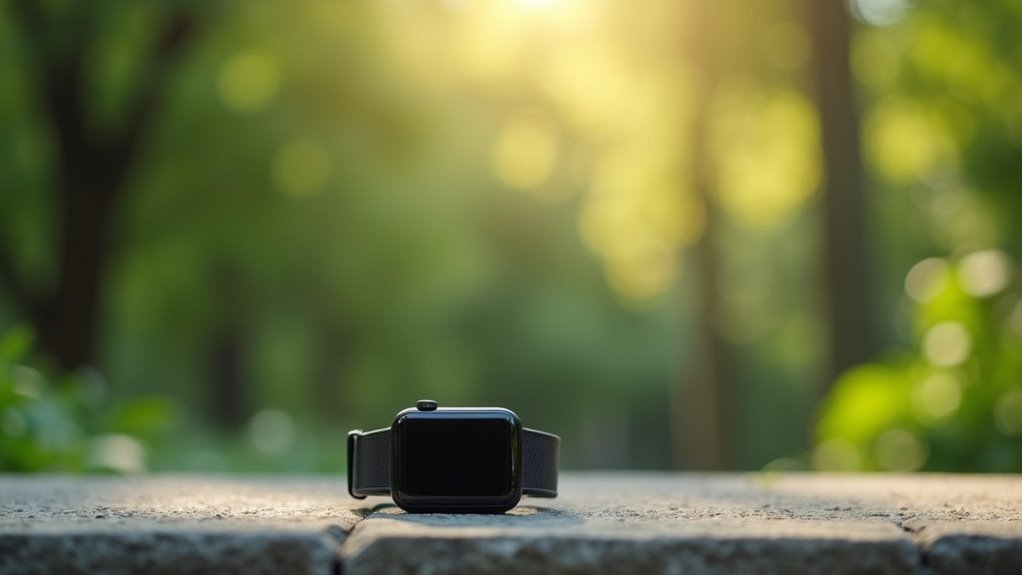
How can your smartwatch transform from a simple step counter into an intelligent health advisor that understands your unique needs? Through natural language processing, your wearable device interprets both physiological data and voice inputs to create personalized health recommendations.
You can ask complex health questions naturally, report symptoms hands-free, and receive tailored insights based on your historical patterns.
Machine learning models analyze your continuous data streams—heart rate variability, sleep patterns, activity levels—alongside conversational context to filter noise and adjust for your individual variances. This creates actionable feedback that adapts to your specific goals, whether you’re improving sleep quality or managing stress triggers. The wearable AI market is projected to reach $166.5 billion by 2030, driven largely by these advanced health monitoring capabilities.
- Voice commands enable hands-free health queries and real-time symptom reporting
- AI correlates physiological trends with your lifestyle and environmental factors
- Personalized goals replace generic health advice through historical data analysis
- Natural language exploration makes complex health data accessible and interactive
- Contextual integration improves recommendation relevance beyond basic metrics
Accessibility Features for Elderly and Mobility-Limited Users
While traditional fitness trackers often overlook the specific needs of elderly and mobility-limited users, voice-enabled wearables are breaking down barriers that have long prevented these populations from accessing extensive health technology.
| Challenge | Voice Solution |
|---|---|
| Emergency situations requiring help | Voice-activated emergency alerts connect instantly to caregivers |
| Memory difficulties affecting medication | AI assistive devices like MemPal provide gentle reminders |
| Hearing impairments limiting communication | Real-time transcriptions and vibration alerts guarantee connection |
You’ll find these devices offer hands-free navigation through GPS guidance, reducing fall risks with environmental hazard alerts. Voice commands control smart home systems, enhancing independence without complex interfaces. Medical alert systems respond to vocal triggers, dramatically reducing response times while family communication features keep loved ones connected through real-time updates. Advanced wearables now incorporate sophisticated sensors that can detect subtle changes in body conditions, enabling early intervention for health complications before they become critical emergencies.
The Future of Proactive Healthcare Through Wearable Voice Technology
As voice-enabled wearables evolve beyond simple health tracking, they’re positioning themselves as the cornerstone of predictive healthcare systems that’ll anticipate your medical needs before symptoms appear.
These devices are transforming how you’ll interact with healthcare by creating seamless integration between real-time monitoring and proactive intervention strategies. Value-based care arrangements will increasingly rely on these wearable technologies to enhance patient outcomes through continuous monitoring and engagement.
Healthcare becomes proactive rather than reactive as wearables bridge the gap between continuous monitoring and preventive medical action.
Your wearable will become a sophisticated health companion that doesn’t just track—it predicts, prevents, and personalizes care through advanced AI integration.
- Predictive analytics will anticipate health crises before they occur, enabling preventive interventions
- Voice-activated emergency protocols will automatically contact healthcare providers during detected anomalies
- Smart home ecosystem integration will adjust your environment based on health metrics
- Neurological monitoring capabilities will detect early signs of conditions like Parkinson’s disease
- Conversational health agents will provide personalized medical guidance through natural language interactions
Frequently Asked Questions
How Long Does the Battery Last With Continuous Voice Monitoring Enabled?
Continuous voice monitoring typically reduces your smartwatch’s battery life by 1-3 days compared to normal use. You’ll likely get 3-7 days total, depending on your device’s capacity and other active features.
Can Voice Commands Work Accurately in Noisy Environments or Crowded Spaces?
Voice commands don’t work reliably in noisy environments. Your accuracy drops from 97% in quiet settings to just 30% with severe background noise like crowds or children, making crowded spaces particularly challenging.
What Happens to My Health Data if I Switch Devices or Brands?
You’ll likely face manual data transfer when switching devices, risking data loss due to incompatible formats between brands. You’ll need to re-consent to new privacy policies, potentially exposing your information to different risks.
Are Voice-Activated Health Features Covered by Health Insurance or HSA Accounts?
You’ll find that most voice-activated health features aren’t covered by insurance or HSA accounts. Administrative functions like prescription refills might be supported, but wellness voice assistants typically don’t qualify for medical reimbursement.
How Much Do Voice-Enabled Health Wearables Typically Cost Compared to Basic Fitness Trackers?
You’ll pay around $99-$250+ for voice-enabled health wearables compared to $30-$100 for basic fitness trackers. Voice features, microphones, speakers, and advanced health sensors typically cost you 2-3 times more than simple step counters.
In Summary
You’re witnessing the dawn of truly intelligent health monitoring. Your voice-enabled smartwatch isn’t just tracking steps anymore—it’s becoming your personal health guardian. You’ll receive real-time insights, predictive warnings, and seamless healthcare connectivity through simple voice commands. As this technology evolves, you’ll experience proactive healthcare that anticipates your needs before symptoms appear. Your wrist will soon hold the power to transform how you monitor, manage, and maintain your health daily.

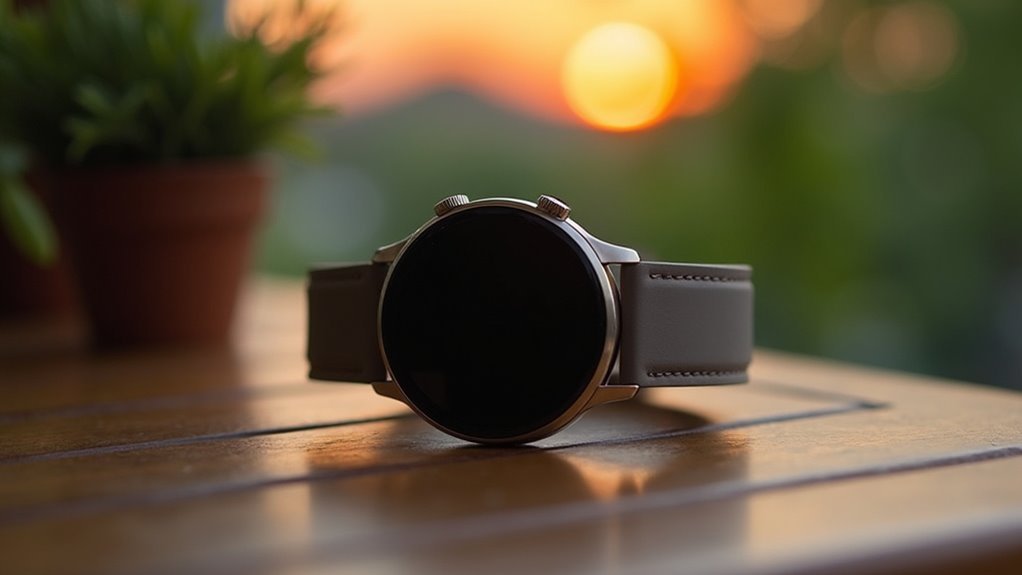
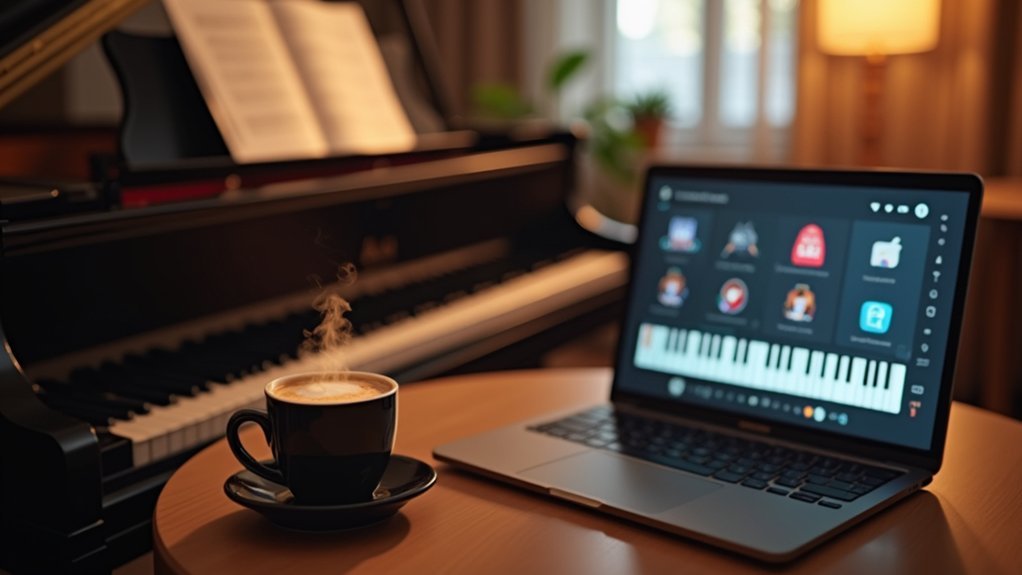
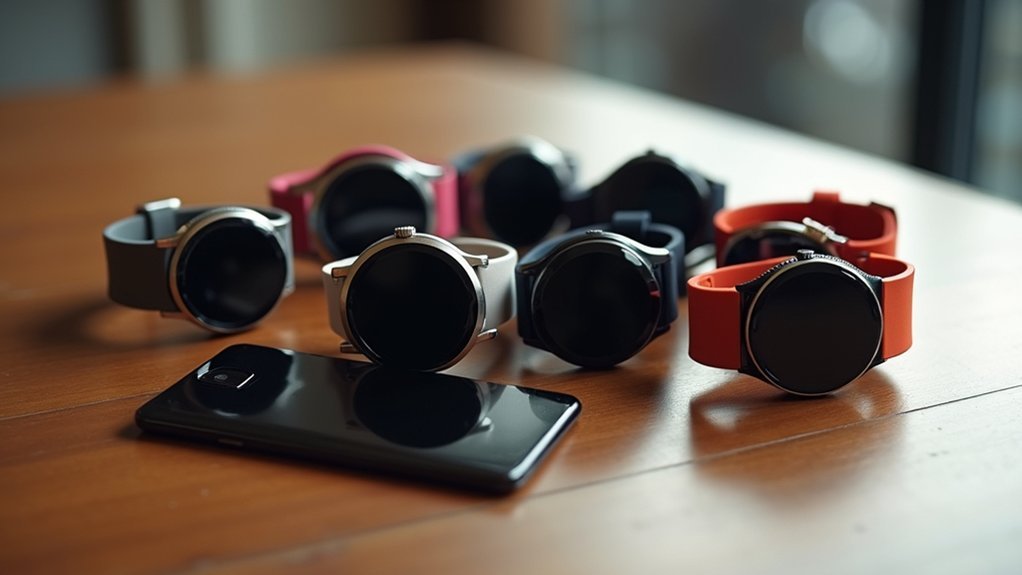
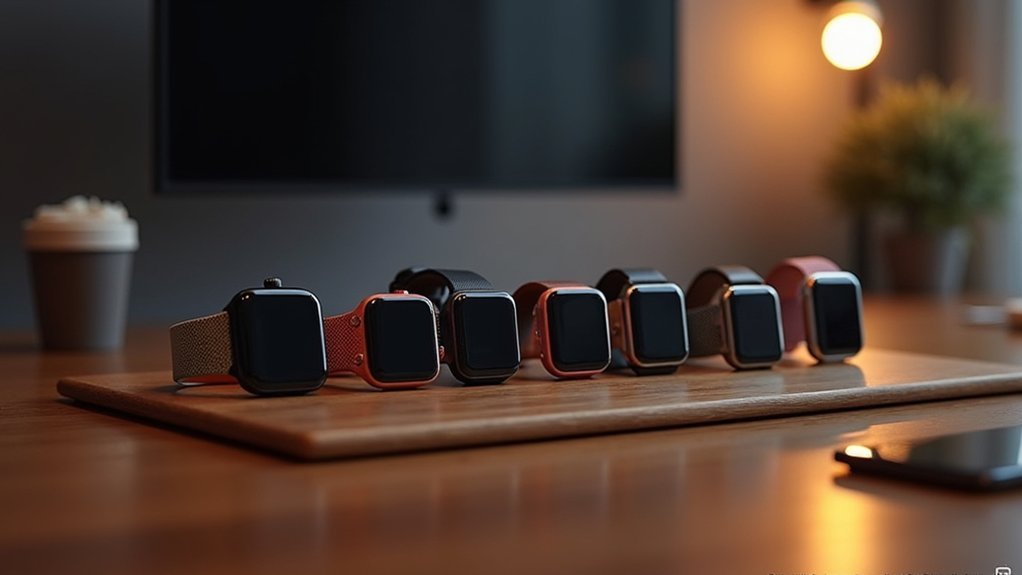
Leave a Reply